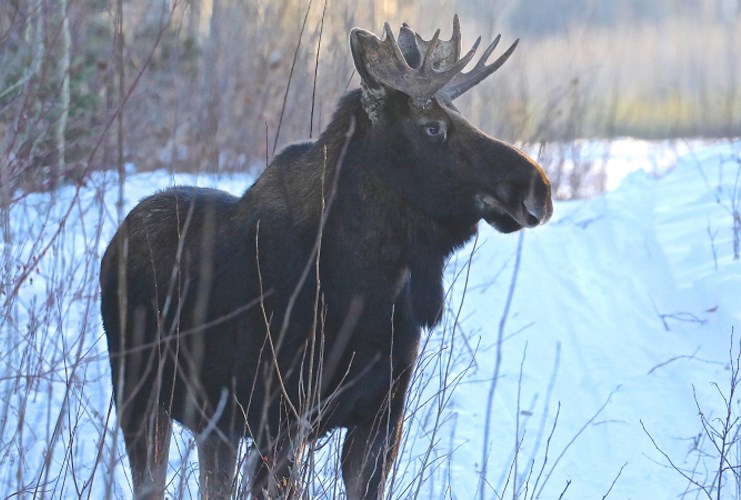A UNBC researcher's wildlife camera helped save a bull moose that wandered into the Prince George Airport's airfield area, according to information released by the university.
Ecosystem science and management researcher Roy Rea has been working with the airport since 2007 on a wildlife monitoring program, and in 2009 he and his students set up a network of digital wildlife cameras around the airport grounds. On Nov. 28, one of Rea's cameras captured an image of a healthy bull moose – on the wrong side of the airport security fence.
“We knew right away this was something that should not be airside. A moose is certainly something we don’t want to have walk in front of an aircraft," Rea said in a press release. "(But) moose populations in this area are down 70 per cent and we’d rather like to see that animal survive and breed instead of being turned into hamburger."
Rea quickly reached out to airport operations manager Trevor Gust, and they started working on a plan to safely move the moose along.
Rea and Gust believed the moose likely got into the airport grounds through a gate that was left open in a storage compound. Once it was inside the fence, it found a section of forest within the fence line and settled in.
“That section of forest is like a Garden of Eden for any moose that gets in there,” Rea said. “That area hasn't been browsed for years and years.”
Over the following weeks, Rea and his students watched their cameras and looked for tracks to try to locate the moose. At the same time, airport staff set up a one-way gate to encourage the moose to leave on its own.
A crew from Yellowhead Helicopters conducted multiple flights over the area the moose had been spotted in, hoping it would encourage the animal to move on.
Airport staff worked with the Conservation Officer Service and government moose biologists to develop a plan to tranquilize the moose and move it off site. But if the moose because a threat to air safety, the team knew they'd have to euthanize it.
When the moose was relocated on Jan. 19, airport and provincial employees sprang into action, moving airport firetrucks to block the moose from running towards the runways.
Then quads were used to gentle herd the moose out of an opening cut in the southwest corner of the security fencing.
“It took a real team effort to ensure the moose was able to get out safely,” Gust said in a press release.
The airport is planning to add another layer of fencing to the area the moose got into the airport grounds, and are testing additional cameras to add to Rea's network.
The arrangement between UNBC and the Prince George Airport is a unique partnership, and has benefited both organizations.
“We have a wildlife program in place and there is a requirement that we are audited by Transport Canada to make to ensure that we're doing our due diligence where wildlife are concerned,” Gust said. “Having the university involved is a tremendous help because the researchers are able to do a lot of the leg work and then we are able to show Transport Canada all the work that has been done.”
Rea and fellow UNBC researcher Matthew Scheideman co-authored a paper in 2017 on using wildlife cameras to assist wildlife management at airports.
“These long-term data sets allow us to really study the patterns of what animals are coming and going, at what time of day they visit the airport, and during what seasons of the year they are more likely to be on the airport property,” Rea said. “It’s a wonderful opportunity for students to work in the areas in which they're interested, like wildlife ecology."

.png;w=120;h=80;mode=crop)

